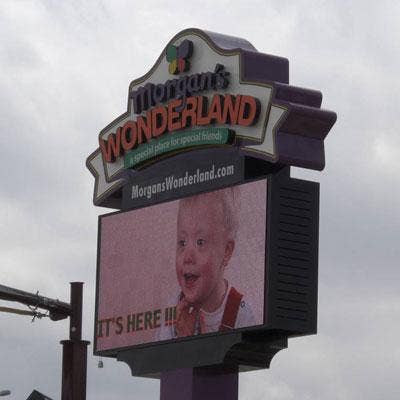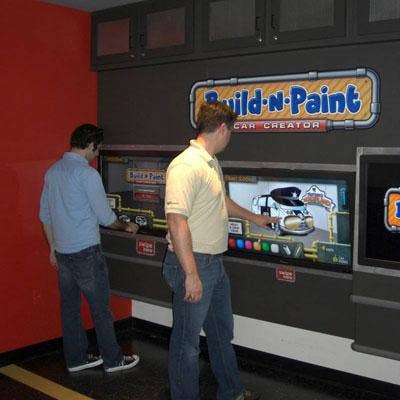A VAR's Story: Learning How To Meet An Amusement Park's IT Needs

Morgan's Wonderland
Internet Contrasts, a San Antonio, Texas-based solution provider, recently completed its largest project -- designing and implementing the entire IT infrastructure for Morgan's Wonderland, an amusement park for the physically challenged.
The comprehensive project included networking, digital signage, RFID, servers and much more. Brandon Zumwalt, owner of Internet Contrasts, recently spoke with CRN about the challenges the VAR overcame to put the project together and what they'd do differently the next time. Here's a detailed look at the project, including some scenes of their work.

In the Beginning
Don't ever let it be said that relationships don't matter. Internet Constrasts won the park project because it had done some previous work for the park's developer, who was a home builder and had started several other profit and non-profit organizations himself, Zumwalt said.
"Someone on his advisory council asked us to take a look at what they were [planning]. They were having issues with distance and they needed a network. They didn't understand the distance problems with Ethernet. We looked at their site plan, got rough estimates and told them they needed fiber optics to go from Point A to Point B."
At left, Internet Contrasts staffers Denton Massey, Vanessa Miller, Zumwalt, and Jacob Rivas stand in front of the Morgan's Wonderland sign.

Getting A Hook In
Soon, Internet Contrasts executives started directing their own questions to the park's planners. What kinds of phones, cameras, computers are you using? What kinds of exhibits will you have and how will they all be controlled?
"They kind of gave me blank stares," Zumwalt said. "They were drawing up plans for the buildings. It was a perfect time for us."
The VAR became a liaison for technical issues ranging from sound to digital signage. "Anything with a 1 or a 0 had our name on it," Zumwalt said. "We had to work with art directors creating different software programs and get the infrastructure in place."
At left, Jacob Rivas and Zumwalt work to address some Pelco IP security camera issues.

Networking Needs
Before long, Internet Contrasts' staff started working with the architects and electrical engineers and learned to help calculate power needs for the IT products. Because they got involved early enough, the VAR helped design the infrastructure that could meet IT and power needs as the park grows, potentially for several decades, Zumwalt said.
"We chose fiber optics with the convergence of data, phone and cameras. We put as much as possible on TCP/IP on fiber optic," he said.
Pictured here, Internet Contrasts' Denton Massey and Brandon Zumwalt configure Alcatel switches.

Beating The Heat
Another challenge with an amusement park project is that there are a lot of open-air pavilions, amphitheatre-like environments, Zumwalt said. If you've ever been to San Antonio in the summer, you know the weather can be grueling on humans, let alone IT equipment.
"It'll hit 100 degrees and if you add the heat from your components to that, you're pushing 130 or 140 degrees for your devices. We had to put a network outdoors, essentially"
The VAR leveraged help from distributor Tech Data, particularly the Advanced Infrastructure Solutions group, to help identify the proper equipment for the project, Zumwalt said.
At left, a NEMA electrical box houses some heavy-duty IT equipment.

Construction Job
Internet Contrasts had never designed or built a network that incorporated such distance and outdoor requirements, Zumwalt said.
"It was pretty much a total learning experience for us. Also, being in on the ground floor at design was new. We usually are working with existing infrastructure," he said.
"We were out there working with construction guys, coordinating to make sure they leave a pull string for the last guy to pull his wire through. The whole project management side was not even technical. We were dealing with vendors who are not technical. We had to tell them all our [equipment] is very sensitive. We also had to address cooling. In some parts, we were creating data rooms and we had to put air conditioners in just for our equipment."
Internet Contrasts' Denton Massey, left, works on some switches in Morgan's Wonderland's data center here.

RFID Solution
One unique solution they helped implement was an RFID project in which every visitor wears a tag and park officials can identify the visitors' location in case they get lost, Zumwalt said. Another company provided the equipment, and it was the VAR's job to get it connected to the network in a data room that is 8 foot by 9 foot.
"This isn't a bank. This is a non-profit. The park isn't designed to make any money. We had to consider maintenance costs long term, tech support and energy [costs]," Zumwalt said. "They can't afford to hire an IT department, so everything we deal with, we had to build in redundancy so we didn't need onsite IT people to run it in the long run. It's also very seasonal, so the HR person may run a POS [station] at some point in the day. They had to have the ability to log in anywhere, at any time of day."
Pictured here is a kiosk where visitors can locate other members of their group through RFID tags.

Model Warehouse
Internet Contrasts started planning out the project last year. They used an IBM server foundation, and built the hardware and software on top of that. Because none of the buildings had been built at that time, the VAR had to build the entire solution and burn in the requisite applications in a model home owned by the park developer's old construction company. Then they had to break it down and move it to the actual site.
"The model home looked like the Tech Data warehouse. Literally, the stuff was everywhere," Zumwalt said. "I had to dedicate a team just to inventory everything. Any time another vendor's part was needed, we had to sign it in or sign it out."
Pictured left are some of the products in the "warehouse," actually a model home.

New Perspective
Like any project involving multiple contractors, there were occasional bumps in the road.
"I found myself having cursing words with a construction guy, who the last thing he wants to do is talk to some pasty white guy who has never worked out in the sun," Zumwalt said. "What you do on paper is totally different than in the field. You get to see what construction folks are really doing. It's a totally different world. They may have poured a foundation or put the IT room in the wrong spot. Some guys are reading the plans wrong."
As pictured, Zumwalt, left, and Massey work on the park's blade server.

Successful Summer
The park held its grand opening in April and finished its first summer successfully, Zumwalt said. The VAR is now "in support mode" and got good feedback from park management while having to make some minor adjustments such as moving some surveillance cameras to a different angle.
"Strategically, we used power over Ethernet, so moving a phone or a camera or a cash register is really simple to do. That all came from the conduit plan we did at the beginning," Zumwalt said.
At left, Internet Contrasts' Denton Massey installs a workstation for the "fix-it-shop" car at Morgan's Wonderland.

Planning Ahead
Part of Internet Contrasts' success on the plan was having a customer that understood what the needs would be, Zumwalt said. The park's managers ran Sea World in San Antonio in the late 1980s and did not use a conduit plan to lay extra cables for the future in that park, he said.
"They had to rip up sidewalks or landscaping or they would hit water pipes," Zumwalt said. "Now, we're only using 10 percent of the amount of fiber we have in the ground right now. They've got years to grow with this [solution]." Pictured here, Massey and Rivas work on the Sensory Village rack.

Looking Back
All told, the project netted the VAR about $750,000 and valuable experience should a similar opportunity present itself in the future.
"I've love to do this again. As far as consulting, there are so many things I'd do different, like the conduit plan as far as making it more accessible. I'd also want to go in and pull more cable. IT has to be more involved in the beginning, especially with the architecture side. In this case, this project shows how technologically advanced the park is, it really helped us. We can say you need this type of equipment to do it right.
Pictured here, Internet Contrasts' Massey manages the cabling system that connects all points of the park together.

The Right Way
Pete Peterson, senior vice president of U.S. sales at Tech Data, said he was impressed at how intelligently Internet Contrasts both planned and executed the solution, keeping the end user's needs in mind.
"Often when we're supporting our customers, we don't necessarily think about what solution this is solving potentially for the end user," Peterson said. "It's gratifying to hear stories about supporting and selling and enabling partners to deliver to an end user. It has such a profound impact not only on business but on people's lives."
At left, Zumwalt and Rivas configure and test the RFID location stations.

Satisfied Customer
Peter Albarian, park director of Morgan's Wonderland, said Internet Contrasts bridged the gap between folks that understood technology and those that didn't.
"They were able to organize and make sure that these different technologies worked together got to an end point where they just flat out worked," Albarian said. "They've been a great support. A lot of these programs, hardware and software, had been used before but not together or in the same sway. They made it happen. They took it very personally to make sure the end result would work and that the park would be successful for it."
Pictured left, Zumwalt and Rivas test the Build'n'Paint car creator station at Morgan's Wonderland.